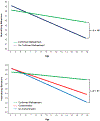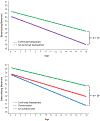Controlling contamination in child maltreatment research: Impact on effect size estimates for child behavior problems measured throughout childhood and adolescence
- PMID: 33719996
- PMCID: PMC8440661
- DOI: 10.1017/S0954579420002242
Controlling contamination in child maltreatment research: Impact on effect size estimates for child behavior problems measured throughout childhood and adolescence
Abstract
Contamination, when members of a comparison or control condition are exposed to the event or intervention under scientific investigation, is a methodological phenomenon that downwardly biases the magnitude of effect size estimates. This study tested a novel approach for controlling contamination in observational child maltreatment research. Data from The Longitudinal Studies of Child Abuse and Neglect (LONGSCAN; N = 1354) were obtained to estimate the risk of confirmed child maltreatment on trajectories of internalizing and externalizing behaviors before and after controlling contamination. Baseline models, where contamination was uncontrolled, demonstrated a risk for greater internalizing (b = .29, p < .001, d = .40) and externalizing (b = .14, p = .040, d = .19) behavior trajectories. Final models, where contamination was controlled by separating the comparison condition into subgroups that did or did not self-report maltreatment, also demonstrated risks for greater internalizing (b = .37, p < .001, d = .51) and externalizing (b = .22, p = .028, d = .29) behavior trajectories. However, effect size estimates in final models were 27.5%-52.6% larger compared to baseline models. Controlling contamination in child maltreatment research can strengthen effect size estimates for child behavior problems, aiding future child maltreatment research design and analysis.
Keywords: child maltreatment; contamination; externalizing behaviors; internalizing behaviors.
Figures


References
-
- Achenbach T (1991). Integrative guide for the 1991 CBCL/4-18, YSR, and TRF profiles. University of Vermont.
-
- Achenbach TM, Dumenci L, & Rescorla LA (2002). Ten-year comparisons of problems and competencies for national samples of youth: Self, parent and teacher reports. Journal of Emotional and Behavioral Disorders, 10(4), 194–203. 10.1177/10634266020100040101 - DOI
-
- Barnett D, Manly JT, & Cicchetti D (1993). Defining child maltreatment: The interface between policy and research. In Cicchetti D & Toth SL (Eds.), Advances in Applied Developmental Psychology: Child Abuse, Child Development and Social Policy (pp. 7–74). Ablex.
-
- Caspi A, Houts RM, Belsky DW, Goldman-Mellor SJ, Harrington H, Israel S, Meier MH, Ramrakha S, Shalev I, Poulton R, & Moffitt TE (2014). The p factor: One general psychopathology factor in the structure of psychiatric disorders? Clinical Psychological Science, 2(2), 119–137. 10.1177/2167702613497473 - DOI - PMC - PubMed
Publication types
MeSH terms
Grants and funding
LinkOut - more resources
Full Text Sources
Other Literature Sources
Medical

